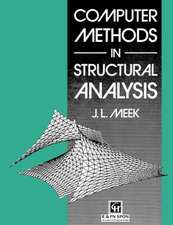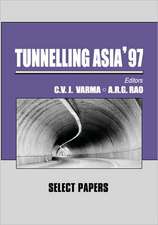Curing Concrete
Autor Peter C. Tayloren Limba Engleză Paperback – 12 dec 2019
The book covers:
- The fundamentals behind hydration
- How curing affects the properties of concrete, improving its long-term performance
- What curing technologies and techniques you can use for different applications
- How to effectively specify, provide, and measure curing in a project
The author also gives numerous examples of how curing—or a lack of it—has affected concrete performance in real-world situations. These include examples from hot and cold climates, as well as examples related to high-performance concrete, performance parameters, and specifications and testing. Written for construction professionals who want to ensure the quality and longevity of their concrete structures, this book demonstrates that curing is well worth the effort and cost.
| Toate formatele și edițiile | Preț | Express |
|---|---|---|
| Paperback (1) | 427.16 lei 6-8 săpt. | |
| CRC Press – 12 dec 2019 | 427.16 lei 6-8 săpt. | |
| Hardback (1) | 1110.74 lei 6-8 săpt. | |
| CRC Press – 10 sep 2013 | 1110.74 lei 6-8 săpt. |
Preț: 427.16 lei
Preț vechi: 502.54 lei
-15% Nou
Puncte Express: 641
Preț estimativ în valută:
81.74€ • 85.73$ • 68.04£
81.74€ • 85.73$ • 68.04£
Carte tipărită la comandă
Livrare economică 01-15 aprilie
Preluare comenzi: 021 569.72.76
Specificații
ISBN-13: 9780367865566
ISBN-10: 0367865564
Pagini: 215
Dimensiuni: 156 x 234 x 12 mm
Greutate: 0.45 kg
Ediția:1
Editura: CRC Press
Colecția CRC Press
ISBN-10: 0367865564
Pagini: 215
Dimensiuni: 156 x 234 x 12 mm
Greutate: 0.45 kg
Ediția:1
Editura: CRC Press
Colecția CRC Press
Public țintă
Postgraduate and ProfessionalNotă biografică
Peter C. Taylor was born and educated in Southern Africa, and gained a B.Sc. and Ph.D. from the University of Cape Town. He spent ten years with consultants in Chicago involved in a wide range of consulting and research projects investigating the effects of raw materials on concrete performance, both in the laboratory and in the field, and since 2007 has been employed at the National Concrete Pavement Technology Center at Iowa State University. He also travels throughout the United States teaching practitioners about the latest technologies available to improve pavement reliability and sustainability. Dr. Taylor is the author of more than 50 publications and is an active member of Transportation Research Board (TRB), ASTM International, and American Concrete Institute (ACI) committees.
Cuprins
Introduction: References. Cementitious Materials Chemistry and Hydration: Introduction. Portland Cement. Supplementary Cementitious Materials. Hydration. Mix Design and Proportioning. Effects of Water. Temperature Effects. Summary. References. Benefits of Curing on Concrete Performance: Introduction. Cracking. Durability. Strength. Modulus of Elasticity. Creep. Sustainability. References. Curing in Practice: Introduction. Selecting Curing Methods. Temperature Control. Moisture Control. Where, When, and How Long? References. Measurement and Specifications: Balancing Theory and Practice. Heating and Cooling. Moisture Control. International Specifications. Verification of Curing. Guide Specification. Payment. References. Real-World Experience: Introduction. Hot Climate. Cold Climate. High-Performance Concrete. Performance Parameters. Specifications and Testing. Summary. References.
Recenzii
"This book explains exactly why curing is so important and shows you how best to do it... There are numerous examples of how curing (or a lack of it) has affected concrete performance in real-world situations. These include examples from hot and cold climates, as well as those related to high-performance concretes. This book is aimed at construction professionals who want to ensure the quality and durability of their concrete structures and demonstrates that curing is well worth the extra effort and cost."
—Concrete, October 2014
"I like the tone and level of the book. While it deals with a critical technical issue, it does so in a manner that makes it immediately attractive and intelligible to the ‘real’ people who have to worry about curing. This will be a great book for site personnel and mid-level managers, as well as students and other practitioners of concrete, to use in order to inform themselves about curing and to help in doing it properly. The book is clear and concise without getting bogged down in unnecessary detail. While some background in cement and concrete is probably needed, the book manages to deal with fairly complex issues in a readily understandable way…"
––Prof. M.G. Alexander, University of Cape Town, South Africa
"This book is a practical yet comprehensive guide for anyone who is involved in concrete construction. It first describes the role curing plays in the hydration process, what properties are influenced by curing, guidance in the application and use of curing, how to measure and specify, and finally real-world guidance drawn from the experiences of others. … Overall, this is an excellent publication that presents fundamental concepts of concrete curing with a practical application of real-world expertise drawn from well-respected practitioners. Why we cure, how to specify it, and what the benefits will be are well presented."
––Jim Grove, P.E., Global Consulting Inc., Ames, Iowa, USA
"A lot of attention is often paid to ensuring that quality materials and methods are used in concrete mixture proportioning but often little attention is paid to curing the concrete. It is essential that proper attention is given to curing to help ensure that the full potential of the desired properties of these mixtures develop. … Preparing, placing, and finishing concrete requires considerable effort. Curing the concrete is often one of the easiest steps and often at minimal additional cost and can greatly improve the quality and durability of the concrete structure."
––Dave Suchorski, P.E., FACI, Ash Grove Cement Co, Overland Park, Kansas, USA
"… the flow is from theory to practice, including case studies. Therefore, the approach and the selection of topics seem excellent. Moreover, for every parameter, including cracking, durability, strength, etc., the same flow exists and the fundamentals are first explained. I liked this approach."
––Dr. İsmail Özgür Yaman, Middle East Technical University and Turkish Cement Manufacturers’ Association, Turkey
"The book was written to explain the benefits of curing concrete and to educate readers on how to select and apply a curing method. The book covers topics such as the fundamentals behind hydration; how curing affects the properties of concrete; curing technologies and techniques; and how to specify, provide, and measure curing."
––Concrete International, December 2013
—Concrete, October 2014
"I like the tone and level of the book. While it deals with a critical technical issue, it does so in a manner that makes it immediately attractive and intelligible to the ‘real’ people who have to worry about curing. This will be a great book for site personnel and mid-level managers, as well as students and other practitioners of concrete, to use in order to inform themselves about curing and to help in doing it properly. The book is clear and concise without getting bogged down in unnecessary detail. While some background in cement and concrete is probably needed, the book manages to deal with fairly complex issues in a readily understandable way…"
––Prof. M.G. Alexander, University of Cape Town, South Africa
"This book is a practical yet comprehensive guide for anyone who is involved in concrete construction. It first describes the role curing plays in the hydration process, what properties are influenced by curing, guidance in the application and use of curing, how to measure and specify, and finally real-world guidance drawn from the experiences of others. … Overall, this is an excellent publication that presents fundamental concepts of concrete curing with a practical application of real-world expertise drawn from well-respected practitioners. Why we cure, how to specify it, and what the benefits will be are well presented."
––Jim Grove, P.E., Global Consulting Inc., Ames, Iowa, USA
"A lot of attention is often paid to ensuring that quality materials and methods are used in concrete mixture proportioning but often little attention is paid to curing the concrete. It is essential that proper attention is given to curing to help ensure that the full potential of the desired properties of these mixtures develop. … Preparing, placing, and finishing concrete requires considerable effort. Curing the concrete is often one of the easiest steps and often at minimal additional cost and can greatly improve the quality and durability of the concrete structure."
––Dave Suchorski, P.E., FACI, Ash Grove Cement Co, Overland Park, Kansas, USA
"… the flow is from theory to practice, including case studies. Therefore, the approach and the selection of topics seem excellent. Moreover, for every parameter, including cracking, durability, strength, etc., the same flow exists and the fundamentals are first explained. I liked this approach."
––Dr. İsmail Özgür Yaman, Middle East Technical University and Turkish Cement Manufacturers’ Association, Turkey
"The book was written to explain the benefits of curing concrete and to educate readers on how to select and apply a curing method. The book covers topics such as the fundamentals behind hydration; how curing affects the properties of concrete; curing technologies and techniques; and how to specify, provide, and measure curing."
––Concrete International, December 2013
Descriere
Curing is often low on the list of priorities on the construction site, but it can improve the hydration and performance of concrete, while reducing the risk of cracking. This book explains why curing is important and shows you how to do it more effectively. The author covers the fundamentals behind hydration, how curing affects the properties o













